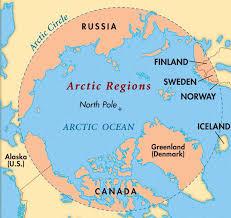‘Mirror, mirror on the wall’: Nordic beauty contests in the Arctic
Nordic peoples and, indeed, the world around are used to the phrase ‘Nordic cooperation‘. The Stoltenberg report of 2009 and its political follow-up have nourished cooperative expectations in the fields of foreign and security policy. However, in the Arctic there is also a considerable competitive element (jealousies) among these countries. Rivalry between states may result from divergent interests, but the paradoxical point here is that it may also be caused by similar interests. I will refer to this as ‘parallel action’.
From the Baltic to the Arctic
Parallel action may occur among countries (usually non-great powers) that share a common task environment plus have common interests and values. The more they cooperate in relation to this environment, the more they will also compete. This is part of a beauty contest, whose audience is both the world around them and their own domestic publics. Sweden and Denmark faced a common task environment in the 1990s: the re-emerged Baltic republics. It was seen as essential both to sustain their sovereignties and to guide them towards membership in Western institutions. The process came to involve both Danish-Swedish cooperation and rivalry. ‘Who is the leader of the emerging Baltic Sea region?’ was the unasked question among the two. On a specific point, who should host the secretariat of the newly established Council of Baltic Sea States, Copenhagen or Stockholm? Likewise, Finland and Sweden competed in relation to Finland’s EU Northern Dimension initiative instead of pooling forces.
With the Baltic Sea hype repeating itself on a larger scene in the Arctic mega-region in recent years, can we observe a similar action pattern among Nordic states in this region? According to the definition adopted by the Arctic Council, the Arctic means the geographical areas north of the Polar Circle (experiencing midnight sun as well as polar night). There are essentially two arenas in the Arctic, where Nordic state interests overlap:
- The Barents region, encompassing northern Norway, Sweden, Finland and Russia
- The Polar Sea (Arctic Ocean). The Polar Sea coastal states include Russia, Norway (Svalbard), the Kingdom of Denmark (Greenland), Canada, and the US (Alaska).
More divergent than parallel action
Sweden and Finland are land-locked in relation to the Arctic Ocean, so their tangible interests are limited to the Barents region. Compared to other Arctic territories, this region is rather developed and industrialized (mining in Sweden and Finland).
Norway is a player in both arenas at stake here. The Gulf Stream, not least, makes Northern Norway more densely populated than Northern Sweden or Finland. Fishing, oil and gas exploitation are the main industries. Bordering Norway, Russia’s militarized Murmansk region offers both local opportunities and vulnerabilities – such as the risk of nuclear waste proliferation, for instance, ruining Norway’s unique fishing grounds.
The Kingdom of Denmark – encompassing Denmark, the Faroe Islands and Greenland – is a Polar Sea coastal state and claims an extended continental shelf encompassing the North Pole. The heterogeneous composition of the realm often makes its Arctic policies compromise products, and Copenhagen easily gets caught between Nuuk (or Thorshavn) on one hand and Brussels (the EU) on the other. It may also be caught between the West-Nordic hunting cultures (re seals, whales, etc.) and its own post-modern norms. Copenhagen cannot just overrule its two brethren in the realm, since the persistence of the Kingdom is a necessary condition for Denmark being Arctic in the first place and thereby a significant player among the Arctic great powers.

Iceland unfortunately falls between the two chairs – the Barents arena and the Polar Sea arena. However, with its location and well-functioning infrastructure (e.g. deep-water ports) Iceland has successfully branded itself as the port of entry to the North-Eastern sea-route. For this reason, not least, Reykjavik has attracted considerable Chinese/Asian interest.
On this basis there is more divergent than parallel action among the Nordics in the Arctic. For purely geopolitical and geo-economic reasons, they have different interests in the Arctic. A fine indicator of this are the themes developed by each country preparing to chair the Arctic Council (for a 2-year term). Of course, there is much overlapping regarding good intentions, but important nuances exist. With no territory or constituency in the Polar Arctic, Sweden and Finland can afford a globalist profile there, including the prioritizing of biodiversity as well as environmental and climate concerns. On the other hand, the Kingdom of Denmark and – especially – Norway have given more weight to human living conditions. In a Norwegian formulation, ‘use’ of the Arctic is just as important as the protection of it. These basic differences naturally lead to agenda competition in the Arctic Council. This is quite straightforward and understandable.
The beauty contests
Nonetheless, parallel action can be discerned at the identity (discourse) level: ‘Who is the most Arctic?’ is the essential question, as long as ‘Arctic’ remains a buzzword. Much reputation and diplomatic clout is at stake in this beauty contest. Former Finnish Prime Minister Alexander Stubb has advocated more use of the term ‘Arctic’ (January 2015). He suggested the term ‘Scandinavian Arctic’ for Northern Norway, Sweden, and Finland, as his predecessor had commissioned a report on further cooperation in this area (‘Growth from the North’). Similarly, the name of the annual large-scale ‘Arctic Circle’ conference in Reykjavik exploits Iceland’s immediate neighbourhood to the Polar Circle.
For Denmark the ‘real’ Arctic is the Polar Sea area rather than the Barents region or any part thereof. As early as 2008, the Kingdom of Denmark managed to create the ‘Arctic-5’, the forum of Polar Sea coastal states, by inviting to their first conference in Ilulissat, Greenland. The non-invited members of the Arctic Council were more or less furious and jealous, since they saw this as an act of ‘separatism’ vis à vis the Council; some apparently saw themselves as belonging to an Arctic Champions’ League. In particular Iceland, seeing itself as a coastal state, felt betrayed by Denmark.
We can also identify parallel action more narrowly between Norway and Denmark in the preparation phase for the Ilulissat meeting. The foreign ministers of Denmark and Norway were concerned about the risks of great power territorial bullying in the Arctic, as illustrated by the Russian flag planting at the North Pole or Canadian territorial appetites. As non-great powers among the five Polar Sea coastal states, traditionally supporting international law, it would be natural if one of them took the initiative for a summit among the five, pre-empting further flag plantings and reassuring each other about the validity of the UN Convention on the Law of the Seas (UNCLOS). But who should host such a meeting – the Kingdom of Denmark or Norway? And in which format? The Kingdom of Denmark proved quickest to send out invitations (to Ilulissat), whereas Norway grudgingly had to accept. Norway, chairing the Arctic Council, had seen this organization as the proper forum. Thus, the Kingdom will be emphasized in textbooks and popular dissemination as the country that made the decisive contribution at a critical point in time towards saving the Arctic peace.
From the outside one may regard the jealousy aspect of parallel action from the humorous side. However, there is nothing embarrassing about the phenomenon for those involved. The behaviour at stake is rational for sovereign units engaged in similar tasks, especially when significant reputation can be earned. The main thing however, is that the cooperative side of the coin is not lost in the process. Also, it should not be overlooked that too much jealousy makes the soil fertile for outside great powers to play divide-and-rule among the Nordics.
DIIS Eksperter

